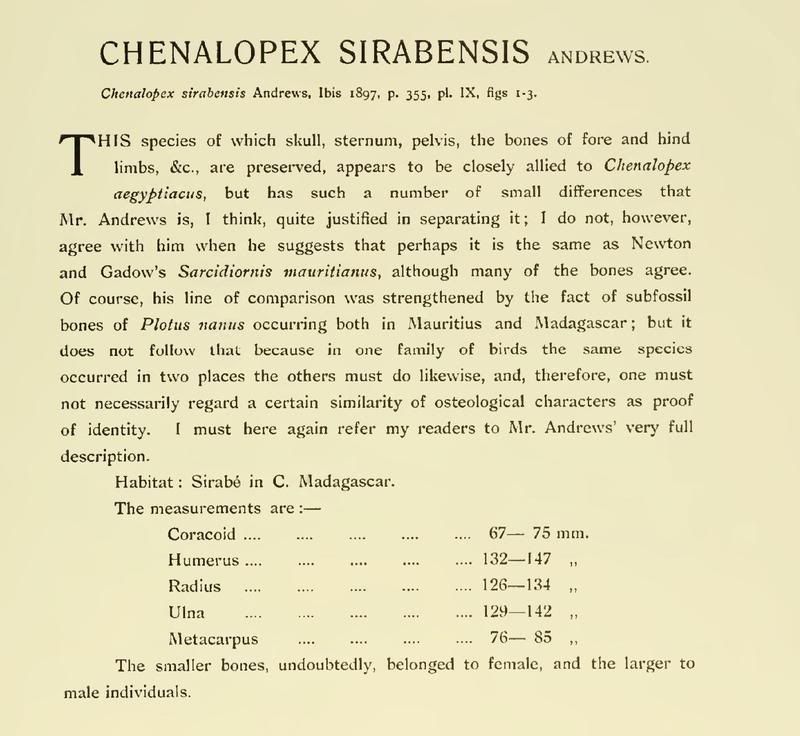|
|
Post by Carlos on Jul 5, 2006 19:43:32 GMT
Alopochen sirabensis (Andrews) 1897 Late Pleistocene, subrecent of Madagascar Primary materials: Materiaal: cranium, vertebrae, humerus, radius, ulna, coracoïdeum, metacarpus, scapula, tarsometatarsus, tibiotarsus, femur, pelvis Kàlmàn Lambrecht, Handbuch der Palaeornithologie 1024 p. (1933) Gebrüder Borntraeger, Berlin See also: Pierce Brodkorb, Catalogue of fossil birds. Part 2 (Anseriformes through Galliformes) Bulletin of the Florida State Museum, Biological Sciences 8 (1964): 195-335 home.planet.nl/~by000012/SM/Fossil/FossilAnati.htm |
|
|
|
Post by another specialist on Aug 26, 2007 9:29:04 GMT
# Malagasy Shelduck or Madagascar Shelduck, Alopochen sirabensis (may be subspecies of A. mauritianus) - Madagascar, prehistoric en.wikipedia.org/wiki/Alopochen |
|
|
|
Post by another specialist on Aug 26, 2007 9:31:36 GMT
There are four fûrther sub-fossil Anatidae known from the region; Centrornis majori andAlopochen sirabensis from Madagascar, A. mauritiana from Mauritius and Masearenachen kervazoi from Réunion. These taxa are al1 Sheldgeese, related, possibly to the Afi-ican Egyptian Goose A. aegyptiacus (ANDREWS, 1897; COWLES, 1987, 1994; GOODMAN & RAKOTOZAFY, in press.). There are no recent records of any sheldgoose or shelduck species in the region away from Seychelles (see Vagrant species). www.horizon.documentation.ird.fr/exl-doc/pleins_textes/pleins_textes_6/colloques2/010008478.pdf |
|
|
|
Post by another specialist on Jul 17, 2008 21:47:46 GMT
 Extinct birds : an attempt to unite in one volume a short account of those birds which have become extinct in historical times : that is, within the last six or seven hundred years : to which are added a few which still exist, but are on the verge of extinction (1907) |
|
|
|
Post by Peter on Nov 2, 2014 16:28:03 GMT
Radiometric date
14C age (years BP), ±1 σ: 1380±90
Calibrated date, ±2 σ: AD 437–875
Source: Tyrberg, T. (2009). Holocene avian extinctions. In: Turvey, S.T. (editor) (2009). Holocene extinctions. Oxford University Press, Oxford, UK.
|
|
|
|
Post by Melanie on May 25, 2022 20:22:17 GMT
Sexual dimorphism and interpopulation size variation in the extinct Malagasy waterbird Alopochen sirabensis (Anseriformes: Anatidae)Neues Jahrbuch für Geologie und Paläontologie - Abhandlungen. 304 (2): 115–124. doi:10.1127/njgpa/2022/1059 Abstract: Sexual dimorphism and interpopulation size variation in the extinct Malagasy waterbird Alopochen sirabensis (Anseriformes: Anatidae) - Neues Jahrbuch für Geologie und Paläontologie - Abhandlungen Band 304 Heft 2 — Schweizerbart science publishers Subfossils of different land vertebrate groups dating from Madagascar’s Late Pleistocene and Holocene have been excavated, including extinct birds such as the waterbird Alopochen sirabensis (Anseriformes, Anatidae), a type of sheldgoose. Material of this species is relatively common at certain subfossil sites that today include areas with different ecosystems than a few thousand years ago when these populations were still extant. Herein we examine aspects of postcranial osteological variation in this species, using comparative data from skeletal specimens of the sole extant member of the genus, A. aegyptiacus, for extrapolation, and infer different aspects of the extinct species biology via traditional osteometric analyses. Alopochen sirabensis shows no evidence of sexual dimorphism nor geographic variation in body size. Its body mass is estimated to have been about 2.2 kg. www.schweizerbart.de/papers/njgpa/detail/304/101374/Sexual_dimorphism_and_interpopulation_size_variati?af=crossref
|
|